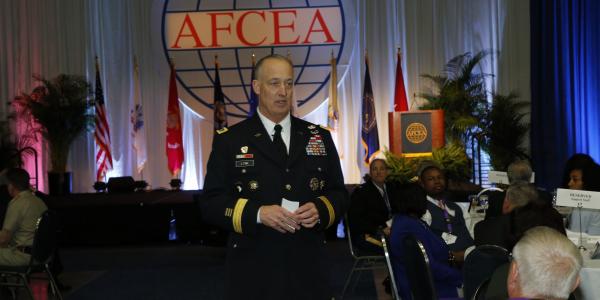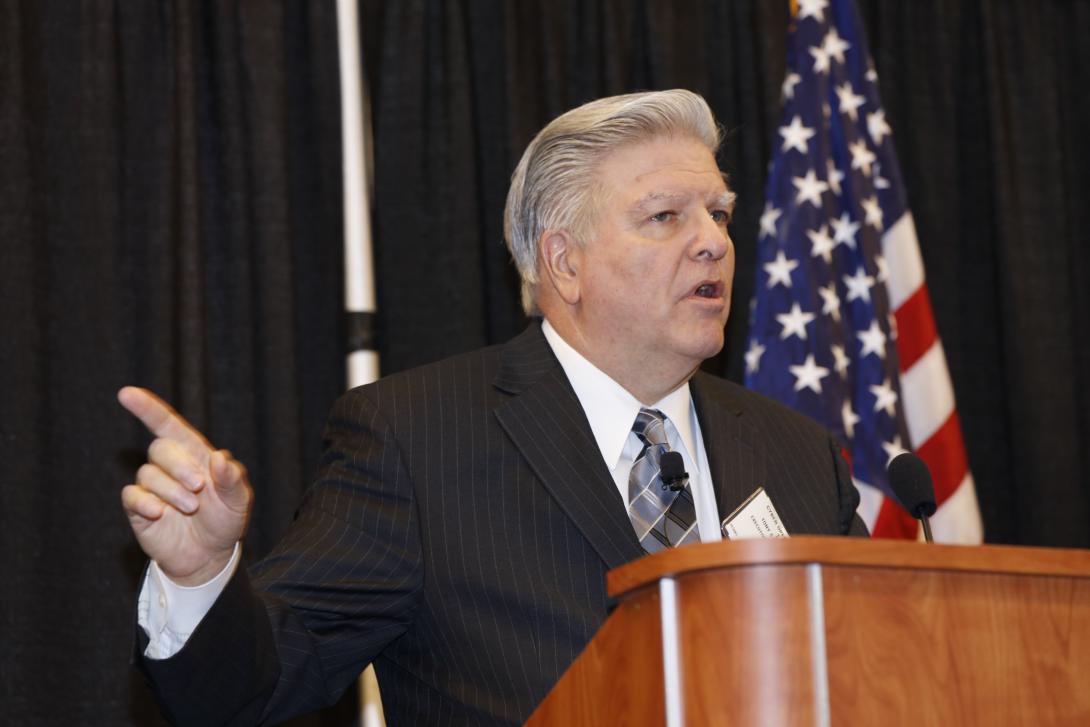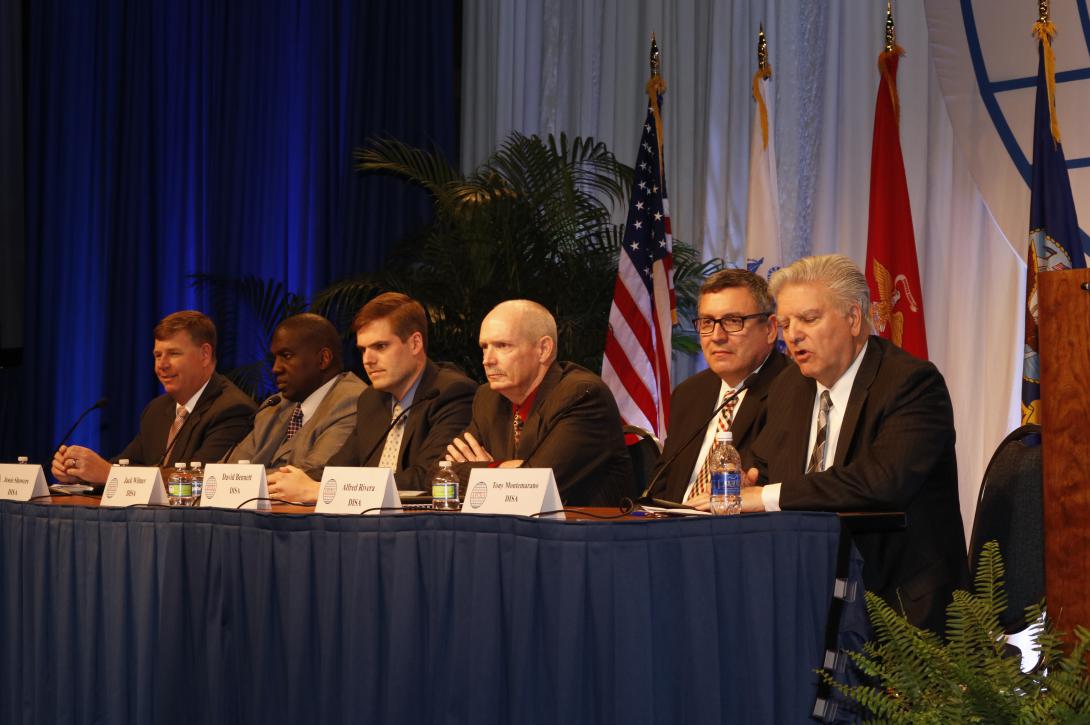DISA Looks to Industry for Future Defense Information Systems
Defensive Cyber Operations Symposium 2016
The SIGNAL Magazine Online Show Daily, Day 1
Quote of the Day:
“It’s cyberwarfare, and it’s daily. It’s happening on our networks.”— Lt. Gen. Alan R. Lynn, USA, director, Defense Information Systems Agency and commander, Joint Force Headquarters-Department of Defense Information Network
The next generation of U.S. military information systems will be a product of the private sector, if the Defense Information Systems Agency’s (DISA’s) plans come to fruition. The agency already is relying on industry for key services, and this partnership will increase in the coming years, say DISA leaders.
Driving this cooperation are some harsh realities. Cyber defense increasingly is becoming more desperate as a wide range of adversaries improve their malevolent abilities and broaden their targets. Mobile communication capabilities are emerging from the consumer market faster than the military can develop them for its own use. And, commercial services are replacing military equivalents as tight budgets squeeze defense organizations out of their traditional business models.
These causes and their consequences were front and center at AFCEA’s Defensive Cyber Operations Symposium 2016, being held April 20-22 at the Washington, D.C., Convention Center. While cybersecurity was a major topic of discussion, the symposium’s first day more closely mirrored its theme of “Rethinking How We Build the Networks: Synchronizing DoD and Industry for Internet 2.0.”
Businesses seeking to work with DISA first must understand DISA, offered Tony Montemarano, executive deputy director, DISA. He described in detail changes coming from an agency reorganization that takes effect May 1. Traditional portfolios have been rearranged to reflect new emphases and service patterns.
Montemarano explained how several longtime DISA officials have new responsibilities. Among them: Alan Lewis is taking over defense spectrum planning and allocation; Brig. Gen. Brian Dravis, USAF, is supporting the Pentagon and Joint Information Environment (JIE) technical implementation; John Hickey will have most of the activity associated with cyber; Capt. Al Holtslander, USN, will have cloud, mobility and Defense Enterprise Office System services development; and Jason Martin carries Win 10, EVoIP and DISANet.
Many others have new areas of operation that will change the way industry works with DISA elements. Montemarano noted that DISA has two new contract vehicles in addition to its traditional set: SETI and Encore III.
“We are under really severe budgetary challenges. Each session gets worse,” Montemarano said. “We are contracting in the physical sense.”
DISA’s director, Gen. Alan R. Lynn, USA, focused on industry’s expanded role in future agency activities. “We want the technology industry to partner with us to develop the next generation of military [information technology] services,” Gen. Lynn said. “We’re seeking more opportunities to provide CRADAs [cooperative research and development agreements] with industry.”
One business opportunity example Gen. Lynn cited is network anomaly detection. “If you have something that allows seeing anomalies better, we’ll plug it into our systems,” he said, addressing industry. That is a near-term need; for the medium term, DISA will need software-defined networks.
And, above all, security measures reign supreme. “If you have novel ideas of how to do encryption, we’re all ears,” the general stated. DISA’s efforts to build out the network, which are essential with the looming Internet of Things, will rely on the assured identity and security piece, he added.
Gen. Lynn acknowledged the difficulties that startup companies have doing business with DISA and its defense acquisition rules. “Startup companies have about nine months to produce results,” he observed. “We realize that, and we’re trying to work a new paradigm for startup companies. We’re learning as we go.”
But regardless of the size of the contractor, Gen. Lynn emphasized one key point. “Lastly, remember, you have to give me a good deal.”
The budget squeeze Montemarano cited has forced DISA to economize in terms of services for its consumers. “Costs and rates are coming down, just not as fast as some people would want them to,” offered David Bennett, director, DISA Implementation and Sustainment Center. “We need to call on our mission partners to provide infrastructure at the lowest possible cost available, and then we provide that to our customers,” he added.
Montemarano allowed, “There’s less and less development going on in the department; we have less and less latitude. We need to rely on commercial products, we no longer are in the build-it-from-scratch mode.”
Alfred Rivera, director, DISA Development and Business Center, said, “We’ve got [a cost] obligation to the military departments. They are in pain” from budget constraints.
The move to the cloud may be a harbinger of future challenges and opportunities, agency officials suggested. Rivera noted that a couple of initiatives are moving forward in terms of what the next generation of cloud service will be—internal or external. “The next generation will be a fully supported cloud solution,” he declared.
John Hickey Jr., DISA risk management executive and CIO, said, “Security gets blamed a lot for not moving to the cloud faster, but I say it’s probably a large contract.” Montemarano added, “I hosted a meeting at DISA once and asked what are all the apps going into the cloud. It was a very short meeting.”
Jessie Showers, DISA infrastructure executive, enunciated a point that lurked beneath all discussion of a DISA-industry partnership. “How do we make the network secure and survivable without hindering innovation?” he asked. “It’s a challenge we need to meet with industry.”
And the cybersecurity threat intruded into nearly every discussion of network capabilities. Showers offered that a future modular network will allow sections to be isolated when they are attacked. Separating these parts will enable the network to be self-healing, he said.
Jack Wilmer, DISA infrastructure development executive, said, “The user community has a desire to have more capability through mobile devices, so we’re working with NSA [the National Security Agency]. The goal is to provide effective security for these mobile devices that may define future military connectivity. “On the unclassified side, we are looking at doing a better job of vetting global applications,” he added.
Gen. Lynn was blunt about the cybersecurity challenge. “The world has changed,” stated the general, who also is the commander, Joint Force Headquarters-Department of Defense Information Network. “In cyber, it used to be almost like an intel game—a gentlemanly sport. People would try to break into your network real smoothly, real slowly.
“Today, they don’t care,” he continued. “They’re kicking in the doors, it’s loud and fast, it’s snatch and grab. The gloves are off.
“It’s cyberwarfare, and it’s daily. It’s happening on our networks,” Gen. Lynn declared.
View videos of the DCOS speakers.
On Day 2 of DCOS 2016: Addresses by Terry Halvorsen, Defense Department chief information officer, and Meg Whitman, president and CEO of Hewlett Packard Enterprise; a CIO panel; and several theater sessions.
And, continuing Education credits apply to 10 Thursday DCOS panels and theater sessions for AFCEA members who attend—or for attendees who become AFCEA members at DCOS!







Comments